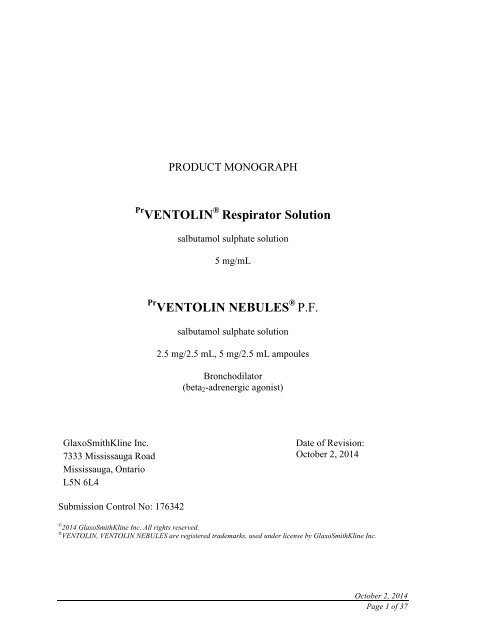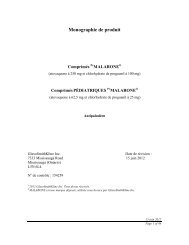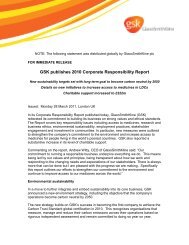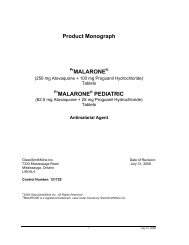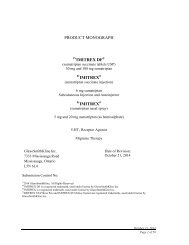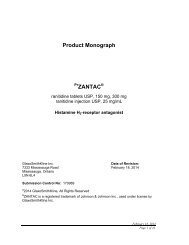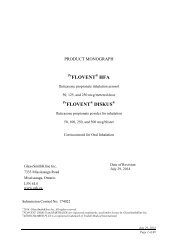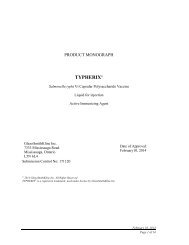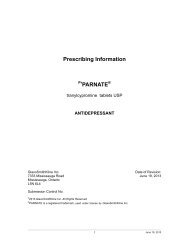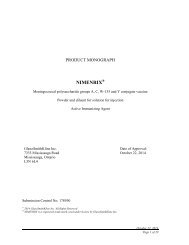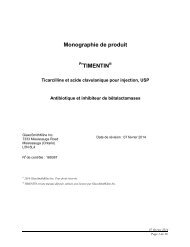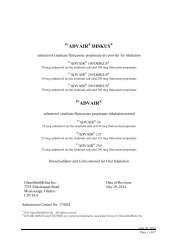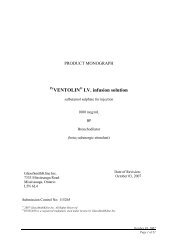Ventolin, Respirator Solution, Nebules - GlaxoSmithKline
Ventolin, Respirator Solution, Nebules - GlaxoSmithKline
Ventolin, Respirator Solution, Nebules - GlaxoSmithKline
You also want an ePaper? Increase the reach of your titles
YUMPU automatically turns print PDFs into web optimized ePapers that Google loves.
is unknown. However, it is suspected in the fatal episodes that cardiac arrest occurredfollowing the unexpected development of a severe acute asthmatic crisis and subsequenthypoxia.Several cases have been reported in which intermittent positive pressure ventilation inacute asthma attacks was related to lethal episodes of hypoxia and pneumothorax. Thismethod of drug administration may be ineffective in patients with severe obstruction andgreatly increased airway resistance, and it may induce severe hypercapnia and hypoxia.During intermittent ventilation therapy, the monitoring of arterial blood gases is highlydesirable. It is advisable that in the event of either hypoxia and pneumothorax orparadoxical bronchospasm the use of the preparation should be discontinued immediatelyand alternate therapy instituted, since in the reported cases the patients did not respond toother forms of therapy until the drug was withdrawn.Special PopulationsPregnant Women: Salbutamol has been in widespread use for many years in humanswithout apparent ill consequence. However, there are no adequate and well-controlledstudies in pregnant women and there is little published evidence of its safety in the earlystages of human pregnancy. Administration of any drug to pregnant women should onlybe considered if the anticipated benefits to the expectant woman are greater than anypossible risks to the fetus (see TOXICOLOGY, Teratogenicity Studies).During worldwide marketing experience, rare cases of various congenital anomalies,including cleft palate and limb defects have been reported in the offspring of patientsbeing treated with salbutamol. Some of the mothers were taking multiple medicationsduring their pregnancies. Because no consistent pattern of defects can be discerned, andbaseline rate for congenital anomalies is 2-3%, a relationship with salbutamol use cannotbe established.Labour and Delivery: Although there have been no reports concerning the use ofinhaled salbutamol during labour and delivery, intravenously administered salbutamolgiven at high doses may inhibit uterine contractions. While this effect is extremelyunlikely as a consequence of using inhaled formulations, it should be kept in mind. Oralsalbutamol has been shown to delay preterm labour in some reports but there are no wellcontrolledstudies which demonstrate that it will stop preterm labour or prevent labour atterm. When given to pregnant patients for relief of bronchospasm, cautious use ofVENTOLIN ® <strong>Respirator</strong> <strong>Solution</strong> and NEBULES ® is required to avoid interference withuterine contractility.Nursing Women: Since salbutamol is probably excreted in breast milk and because of itsobserved tumorigenicity in animal studies, a decision should be made whether todiscontinue nursing or to discontinue the drug, taking into account the benefit of the drugto the mother. It is not known whether salbutamol in breast milk has a harmful effect onthe neonate.October 2, 2014Page 6 of 37
Pediatrics (5 – 12 years):VENTOLIN ® <strong>Respirator</strong> <strong>Solution</strong> and VENTOLIN NEBULES ®VENTOLIN ® <strong>Respirator</strong> <strong>Solution</strong> and VENTOLIN NEBULES ® should be used under thesupervision of an adult who understands the proper use of the nebulizer and/or respirator(as well as VENTOLIN ® <strong>Respirator</strong> <strong>Solution</strong> and/or VENTOLIN NEBULES ® ), andonly as presented by the doctor.Rarely, in children, hyperactivity occurs and occasionally, sleep disturbances,hallucination or atypical psychosis have been reported.Pediatrics (< 5 years of age): Experience is insufficient for recommending the treatmentof children under 5 years of age.Monitoring and Laboratory TestsThe management of asthma should normally follow a stepwise program and patientresponse should be monitored clinically and by lung function tests.Monitoring Control of AsthmaFailure to respond for at least three hours to a previously effective dose of salbutamolindicates a deterioration of the condition and the physician should be contacted promptly.Patients should be warned not to exceed the recommended dose as there may be adverseeffects associated with excessive dosing.The increasing use of fast acting, short duration inhaled beta 2 -adrenergic agonists tocontrol symptoms indicates deterioration of asthma control and the patient’s therapy planshould be reassessed. In worsening asthma it is inadequate to increase beta 2 -agonist useonly, especially over an extended period of time. In the case of acute or rapidlyworsening dyspnea, a doctor should be consulted immediately. Sudden or progressivedeterioration in asthma control is potentially life threatening; the treatment plan must bere-evaluated, and consideration be given to corticosteroid therapy (see DOSAGE ANDADMINISTRATION).Geriatrics: As with other beta 2 -agonists, special caution should be observed whenusing VENTOLIN ® <strong>Respirator</strong> <strong>Solution</strong> and VENTOLIN NEBULES ® in elderlypatients who have concomitant cardiovascular disease that could be adverselyaffected by this class of drug.ADVERSE REACTIONSBecause clinical trials are conducted under very specific conditions the adversereaction rates observed in the clinical trials may not reflect the rates observed inpractice and should not be compared to the rates in the clinical trials of anotherdrug. Adverse drug reaction information from clinical trials is useful for identifyingdrug-related adverse events and for approximating rates.October 2, 2014Page 7 of 37
Adverse Drug Reaction OverviewAdverse events are listed below; frequencies are defined as: very common (≥1/10),common (≥1/100 and
Drug type Ref Effect Clinical commentIpratropium bromide.Legend: CS=Class StatementCSAcute angle closureglaucoma has beenreported withcoadministration.A small number of cases of acute angleclosure glaucoma have been reported inpatients treated with a combination ofnebulized salbutamol and ipratropiumbromide. Therefore, a combination ofnebulized salbutamol with nebulizedanticholinergics should be usedcautiously. Patients should receiveadequate instruction in correctadministration and be warned not to letthe solution or mist enter the eye.DOSAGE AND ADMINISTRATIONDosing ConsiderationsThe dosage should be individualized, and the patient’s response should be monitored bythe prescribing physician on an ongoing basis.In patients with asthma, if salbutamol is required for relief of symptoms more thantwice a day on a regular daily basis or for an extended period of time, antiinflammatorytherapy (e.g. corticosteroids) should be part of the regimen.Increasing demand for VENTOLIN ® (salbutamol sulphate) <strong>Respirator</strong> <strong>Solution</strong> orVENTOLIN NEBULES ® in bronchial asthma is usually a sign of worsening asthma andindicates that the treatment plan should be reviewed.If a previously effective dose fails to provide the usual relief, or the effects of a doselast for less than three hours, patients should seek prompt medical advice since thisis usually a sign of worsening asthma.As there may be adverse effects associated with excessive dosing, the dosage orfrequency of administration should only be increased on medical advice. However, if amore severe attack has not been relieved by the usual dose, additional doses may berequired. In these cases, patients should immediately consult their doctors or the nearesthospital.VENTOLIN ® <strong>Respirator</strong> <strong>Solution</strong> may be preferred in the treatment of severebronchospasm associated with exacerbations of chronic bronchitis and bronchial asthma.October 2, 2014Page 10 of 37
Recommended Dose and Dosage AdjustmentVENTOLIN ® <strong>Respirator</strong> <strong>Solution</strong>:Adults and Adolescents > 13 years of age: In adults, VENTOLIN ® <strong>Respirator</strong> <strong>Solution</strong>0.5 to 1 mL (2.5 to 5 mg of salbutamol) should be diluted in 2 to 5 mL or more of sterilenormal saline. Treatment may be repeated four times a day if necessary.Children (5 - 12 years): The average dose for a single treatment is 0.25 to 0.5 mL ofVENTOLIN ® <strong>Respirator</strong> <strong>Solution</strong> (1.25 to 2.5 mg of salbutamol) diluted in 2 to 5 mL ormore of sterile normal saline. For more refractory cases, the single dose of VENTOLIN ®<strong>Respirator</strong> <strong>Solution</strong> may be increased to 1 mL (5 mg of salbutamol). Treatment may berepeated four times a day if necessary.If a more severe attack has not been relieved by a treatment, further treatments may berequired. In these cases, patients should be advised to immediately consult their doctor orthe nearest hospital.VENTOLIN NEBULES ® P.F.:Adults and Adolescents ≥ 13 years of age: Patients requiring single doses of 2.5 mg or5 mg may be administered the contents of a single VENTOLIN ® <strong>Respirator</strong> <strong>Solution</strong> unitdose (VENTOLIN NEBULES ® P.F. 2.5 or 5 mg of salbutamol). Treatment may berepeated 4 times a day if necessary.Children (5 - 12 years): Children requiring a single dose of 2.5 mg may be administeredthe contents of a single VENTOLIN ® <strong>Respirator</strong> <strong>Solution</strong> unit dose (VENTOLINNEBULES ® P.F. 2.5 mg of salbutamol). For more refractory cases children may use a5 mg unit dose (see dosage above). Treatment may be repeated 4 times a day if necessary.If a more severe attack has not been relieved by a treatment, further treatments may berequired. In these cases, patients should immediately consult their doctor or the nearesthospital.Missed DoseIf a single dose is missed, instruct the patient to take the next dose at the time when it isdue or if they become wheezy.AdministrationTo ensure administration of the proper dose of the drug, the patient should be instructedby the physician or other health professional in the proper use of the nebulizer system orrespirator system.VENTOLIN ® <strong>Respirator</strong> <strong>Solution</strong> is to be used only under the direction of a physicianemploying either a respirator or nebulizer. VENTOLIN ® <strong>Respirator</strong> <strong>Solution</strong> can be takenby either the nebulization or intermittent positive pressure ventilation method. Thesolution must not be injected or swallowed. When used in a nebulizer delivery may be byOctober 2, 2014Page 11 of 37
a mouthpiece, a face mask, T piece or via an endotracheal tube. The nebulizer should beconnected to a compressed air or oxygen pump. Gas flow should be in the range of 6 to10 L/minute. With an average volume of 3 mL, a single treatment lasts approximately10 minutes. It is advisable to prepare one dose at a time of VENTOLIN ® <strong>Respirator</strong><strong>Solution</strong> or to utilize the Unit Dose (VENTOLIN NEBULES ® P.F.) presentation.When VENTOLIN ® <strong>Respirator</strong> <strong>Solution</strong> is administered through intermittent positivepressure ventilation, the inspiratory pressure is usually 10-20 cm H 2 O and the duration ofadministration varies from 5 to 20 minutes, depending upon the patient and the control ofthe apparatus. This length of administration provides a more gradual and more completelysis of bronchospasm. In several cases it has been reported that the use of intermittentpositive pressure ventilation in acute asthma attacks was related to lethal episodes ofhypoxia and pneumothorax. This method of drug administration may be ineffective inpatients with severe obstruction and may greatly increase airway resistance and possiblyinduce severe hypercapnia and hypoxia. It is highly desirable to monitor arterial bloodgases during intermittent positive pressure ventilation therapy. When there is a risk ofanoxia through hypoventilation, oxygen should be added to the inspired air.In hospitals, VENTOLIN ® <strong>Respirator</strong> <strong>Solution</strong>, diluted (1:5 or 1:10) with sterile normalsaline, should be used within 24 hours from time of dilution when stored at roomtemperature or within 48 hours when stored under refrigeration. As many nebulizersoperate on a continuous flow basis, it is likely that nebulized drug will be released in thelocal environment. VENTOLIN NEBULES ® and VENTOLIN ® <strong>Respirator</strong> <strong>Solution</strong>should therefore be administered in a well ventilated room, particularly in hospitals whenseveral patients may be using nebulizers at the same time.VENTOLIN NEBULES ® are to be used with a nebulizer, under the direction of aphysician. VENTOLIN NEBULES ® are intended to be used undiluted. However, ifprolonged delivery time is desirable (more than 10 minutes) dilution using sterile normalsaline as a diluent may be required.Cleansing and maintenance of the nebulizer must be carefully exercised by strictadherence to the manufacturer's instructions.OVERDOSAGEFor management of a suspected drug overdose, contact your regional Poison ControlCentre.Symptoms and signsThe most common signs and symptoms of overdose with salbutamol are transient betaagonist pharmacologically mediated events (see Warning and Precautions and AdverseReactions). Overdosage may cause tachycardia, cardiac arrhythmia, hypokalemia,hypertension and, in extreme cases, sudden death. Serum potassium levels should bemonitored.October 2, 2014Page 12 of 37
Lactic acidosis has been reported in association with high therapeutic doses as well asoverdoses of short-acting beta-agonist therapy, therefore monitoring for elevatedserum lactate and consequent metabolic acidosis (particularly if there is persistence orworsening of tachypnea despite resolution of other signs of bronchospasm such aswheezing) may be indicated in the setting of overdose.TreatmentConsideration should be given to discontinuation of treatment and appropriatesymptomatic therapy. To antagonise the effect of salbutamol, the judicious use of acardioselective beta-adrenergic blocking agent (e.g. metoprolol, atenolol) may beconsidered, bearing in mind the danger of inducing an asthmatic attack. Duringcontinuous administration of salbutamol <strong>Respirator</strong> <strong>Solution</strong>, any signs of overdosage canusually be counteracted by withdrawal of the drug.ACTION AND CLINICAL PHARMACOLOGYMechanism Of ActionSalbutamol produces bronchodilation through stimulation of beta 2 -adrenergic receptors inbronchial smooth muscle, thereby causing relaxation of bronchial muscle fibres. Thisaction is manifested by an improvement in pulmonary function as demonstrated byspirometric measurements. Although beta 2 -receptors are the predominant adrenergicreceptors in bronchial smooth muscle and beta 1 -receptors are the predominant receptorsin the heart, there are also beta 2 -receptors in the human heart comprising 10% to 50% ofthe total beta-adrenergic receptors. The precise function of these receptors has not beenestablished, but they raise the possibility that even highly selective beta 2 -agonists mayhave cardiac effects. At therapeutic doses, salbutamol has little action on the beta 1 -adrenergic receptors in cardiac muscle.A measurable decrease in airway resistance is typically observed within 5 to 15minutes after inhalation of salbutamol. The maximum improvement in pulmonaryfunction usually occurs 60 to 90 minutes after salbutamol treatment, and significantbronchodilator activity has been observed to persist for 3 to 6 hours.PharmacokineticsAfter inhalation of recommended doses of salbutamol, plasma drug levels are very low.When 100 mcg of tritiated salbutamol aerosol was administered to two normalvolunteers, plasma levels of drug-radioactivity were insignificant at 10, 20 and30 minutes following inhalation. The plasma concentration of salbutamol may be evenless as the amount of plasma drug-radioactivity does not differentiate salbutamol from itsprincipal metabolite, a sulphate ester. In a separate study, plasma salbutamol levelsranged from less than 0.5 ng/mL to 1.6 ng/mL in ten asthmatic children one hour afterinhalation of 200 micrograms of salbutamol.October 2, 2014Page 13 of 37
Five asthmatic patients were given tritium-labelled salbutamol from the nebulizer of anintermittent positive pressure ventilator. In all patients, there was a rapid initial rise inplasma concentration of total radioactivity. In four of the five patients, there was a furtherrise in plasma concentration to a peak at 2 to 4 hours. All patients showed animprovement in FEV 1 with peak improvement at 30 minutes to 2 hours. An average of12.5% of the initial dose was recovered in the urine. Of the radioactivity recovered, 88%was recovered in the first 24 hours. The metabolite in the urine was the same as that inthe plasma. During the first 2 hours, the ratio of free salbutamol to metabolite average2:1, whereas by 8 hours, the ratio was 9:11, and thereafter this reversed ratio wasmaintained.Approximately 10% of an inhaled salbutamol dose is deposited in the lungs. Eighty-fivepercent of the remaining salbutamol administered from a metered-dose inhaler isswallowed, however, since the dose is low (100 to 200 mcg), the absolute amountswallowed is too small to be of clinical significance. Salbutamol is only weakly bound toplasma proteins. Results of animal studies indicate that following systemicadministration, salbutamol does not cross the blood-brain barrier but does cross theplacenta using an in vitro perfused isolated human placenta model. It has been found thatbetween 2% and 3% of salbutamol was transferred from the maternal side to the fetal sideof the placenta.Salbutamol is metabolized in the liver. The principal metabolite in humans is salbutamolo-sulphate,which has negligible pharmacologic activity. Salbutamol may also bemetabolized by oxidative deamination and/or conjugation with glucuronide.Salbutamol is longer acting than isoprenaline in most patients by any route ofadministration because it is not a substrate for the cellular uptake processes forcatecholamines nor for catechol-O-methyl transferase. Salbutamol and its metabolites areexcreted in the urine (>80%) and the feces (5% to 10%). Plasma levels are insignificantafter administration of aerosolized salbutamol; the plasma half-life ranges from 3.8 to7.1 hours.STORAGE AND STABILITYKeep out of the sight and reach of children.VENTOLIN ® <strong>Respirator</strong> <strong>Solution</strong>: Store between 15 to 25ºC. Protect from light.Discard if not used within one month of opening.Overwrapped VENTOLIN NEBULES ® : Store between 2 to 25ºC.VENTOLIN NEBULES ® Removed From Overwrap: Store between 2 to 25ºC. Protectfrom light. Use within 3 months.October 2, 2014Page 14 of 37
Reconstituted VENTOLIN ® <strong>Respirator</strong> <strong>Solution</strong>In hospitals, VENTOLIN ® <strong>Respirator</strong> <strong>Solution</strong>, diluted (1:5 or 1:10), with sterile normalsaline, should be used within 24 hours from time of dilution when stored at roomtemperature or within 48 hours when stored under refrigeration. Instructions for thedilution of VENTOLIN ® <strong>Respirator</strong> <strong>Solution</strong> are given below in Table 2.In the home, the unit dose preparation (VENTOLIN NEBULES ® P.F.), which is predilutedand ready to use, is the most convenient preparation. However, if the standardVENTOLIN ® <strong>Respirator</strong> <strong>Solution</strong> is used, it may be diluted with sterile normal salineimmediately before use. Any unused solution in the nebulizer should be discarded.Table 2Dilution Table for VENTOLIN ® <strong>Respirator</strong> <strong>Solution</strong>Dose (mg) ofSalbutamol(per treatment)Volume (mL) of<strong>Ventolin</strong> ® respirator<strong>Solution</strong>(per treatment)Volume* (mL) of SterileNormal Saline to beadded as diluent1.25 0.25 2-5 mL or more2.5 0.50 2-5 mL or more5 1.00 2-5 mL or more*Approximate volumes only are given. Actual volume of diluent used may vary according to the type of nebulizer andindividual patient needs.DOSAGE FORMS, COMPOSITION AND PACKAGINGVENTOLIN ® <strong>Respirator</strong> <strong>Solution</strong> and VENTOLIN NEBULES ® P.F.VENTOLIN ® <strong>Respirator</strong> <strong>Solution</strong> contains salbutamol sulphate, equivalent to 5 mg ofsalbutamol base per mL. It is an isotonic solution adjusted to pH 3.4 to 4.4 and preservedwith benzalkonium chloride 0.01% w/v. It also contains dilute sulphuric acid and Waterfor Injection. Available in 10 mL bottles.VENTOLIN ® <strong>Respirator</strong> <strong>Solution</strong> Unit Dose (VENTOLIN NEBULES ® P.F.) containssalbutamol sulphate equivalent to 2.5 or 5 mg of salbutamol base (equivalent to1 mg/mL or 2 mg/mL) in 2.5 mL. It is a sterile, isotonic solution adjusted to pH 3.5 to4.5. It also contains sodium chloride, dilute sulphuric acid and Water for Injection.Available in boxes of 20 ampoules.October 2, 2014Page 15 of 37
PART II: SCIENTIFIC INFORMATIONPHARMACEUTICAL INFORMATIONDrug SubstanceProper name:Chemical name:salbutamol sulphateα 1 -[(tert-butylamino)methyl]-4-hydroxy-m-xylene-α, α’-diol sulphate (2:1) saltMolecular formula and molecular mass: [C 13 H 21 NO 3 ] 2 H 2 SO 4, 576.7Structural formula:Physicochemical properties:Description:Solubility:White to almost white powder. It is odourless oralmost odourless.Soluble in 4 parts of water; slightly soluble inethanol (96%), in chloroform and in ether.pH value: 4.3.pKa values: 9.3 and 10.3.Distribution Coefficient:Melting Point:The distribution coefficient of salbutamol betweentwo phases of octanol and water, as determined byHPLC, is log D=-0.5 at pH 7.42 at roomtemperature.Approximately 155ºC, with decomposition.October 2, 2014Page 16 of 37
CLINICAL TRIALSIn controlled clinical trials, the onset of improvement in pulmonary function was within15 minutes, as determined by both maximum mid-expiratory flow rate (MMEF) andFEV 1 . MMEF measurements also showed that near maximum improvement inpulmonary function generally occurs within 60 to 90 minutes following two inhalationsof salbutamol and that clinically significant improvement generally continues for three tofour hours in most patients. In clinical trials some patients with asthma showed atherapeutic response (defined as maintaining FEV 1 values 15% or more above baseline)that was still apparent at six hours. Continued effectiveness of salbutamol wasdemonstrated over a 13-week period in these same trials.In clinical studies, two inhalations of salbutamol taken approximately 15 minutes beforeexercise prevented exercise-induced bronchospasm, as demonstrated by the maintenanceof FEV 1 within 80% of baseline values in the majority of patients. One of these studiesalso evaluated the duration of the prophylactic effect to repeated exercise challengeswhich was evident at four hours in the majority of patients and at six hours inapproximately one third of the patients.The ability of salbutamol to produce bronchodilation in humans has been demonstrated inmany spirometric and plethysmographic studies. Following a challenge withacetylcholine aerosol, in a study examining the effects of salbutamol in airway resistancefollowing challenge testing in 12 patients, the mean airway resistance increased 250%.After salbutamol aerosol (200 micrograms), the mean airway resistance decreased to 78%of the initial value. Challenges with grass pollen or house dust aerosols in five and eightpatients, respectively, increased activity resistance 265% and 255%, respectively.Administration of salbutamol decreased airway resistance to initial levels.Controlled clinical studies and other clinical experience have shown that inhaledsalbutamol, like other beta-adrenergic agonist drugs, can produce a significantcardiovascular effect in some patients, as measured by pulse rate, blood pressure,symptoms, and/or ECG changes.When salbutamol was administered as a metered-dose inhaler preparation to six normalvolunteers, at doses of three or seven inhalations of 100 micrograms, it was observed thatthree inhalations of salbutamol did not alter serum potassium while seven inhalationsresulted in a decrease in serum potassium from 4.4 to 3.8 mEq/L. Thus, recommendeddoses of salbutamol aerosol (two inhalations) would not be expected to alter serumpotassium levels.A double-blind, placebo controlled comparison of the bronchodilator effects ofsalbutamol, inhaled either as a dry powder or as a conventional aerosol, was carried outin 20 adult patients with chronic bronchial asthma. All treatments were significantlybetter than placebo. There was no significant difference between responses to any of thethree dry powder doses (100 mcg, 200 mcg, 300 mcg) but the average response to200 mcg aerosol was significantly greater than that to 200 mcg dry powder.October 2, 2014Page 17 of 37
Salbutamol dry powder (400 mcg) and conventional aerosol (200 mcg) wereadministered to 10 adult asthmatics. There was no statistically significant differencebetween the improvement in FEV 1 obtained 10 minutes after administration of either thedry powder or the aerosol formulation.Salbutamol was administered as a dry powder (50 mcg, 100 mcg, 200 mcg, 400 mcg) andas an aerosol (200 mcg) to 10 adult asthmatics. The greatest responses were obtainedwith salbutamol 400 mcg administered as a dry powder. No effect on blood pressure orpulse rate was observed.Daily improvement in PEFR in response to single doses of inhaled salbutamol (200 mcgdry powder and 100 mcg conventional aerosol) was measured in nine asthmatic children(aged 5-13 years) for six weeks. The order of administration of powder and aerosol wasreversed at the end of three weeks. There was no statistically significant differencebetween the increase in PEFR 5 minutes after either 200 mcg dry powder or after100 mcg aerosol. The total mean increases in PEFR 10 minutes after inhalation ofpowder and aerosol (weeks 1-3) and inhalation of aerosol and powder (weeks 4-6) werenot significantly different.In a double-blind, placebo-controlled study, salbutamol (200 mcg) completely preventedexercise-induced bronchospasm in three of five children, and greatly reduced the effectsin the other two patients.Administration of 10 mg salbutamol as a 0.5% solution through IPPV from a Bennettventilator, given in a 3 minute period, resulted in a 40% increase of FEV 1 with maximumeffect in about 90 minutes. The average duration of effect was 3 hours. The heart ratehad an average increase of 9 beats/minute, peaking after 25 minutes, and lasting for about36 minutes. No ECG changes were observed.Salbutamol solution 0.5% was self-administered at home via a portable nebulizer,without IPPV, by 28 adult patients with severe chronic asthma. The dose was 0.5 mL(2.5 mg salbutamol) in 4.5 mL normal saline, 2 to 4 times daily, and the duration oftreatment period ranged from 0.9 to 2.7 years (mean 1.7 years). For each patient thetreatment period was compared retrospectively with a control period of the same durationpreceding nebulizer therapy. No statistically significant differences between treatmentand control periods were found for pulmonary function tests performed before and after5 puffs of a salbutamol pressurized aerosol, or for number of out-patient emergencydepartment visits, hospitalizations, sick leaves, and days hospitalized. However, therewere significant reductions during the treatment period in the duration of sick leaves andmedical ward treatments, while half of the patients reported that it was easier to sleep andtwo-thirds said it was easier to exercise.In 10 pediatric studies, a total of 189 patients up to 14 years of age were treated withsalbutamol solution 0.5% administered via a portable nebulizer. In most cases, the dosewas between 0.5 mL and 1 mL per treatment, diluted with normal saline, bringing thetotal volume to 2 mL. Children with asthma had very good results from the treatment,October 2, 2014Page 18 of 37
while children with bronchitis or bronchiolitis did not respond well. Salbutamol was verywell tolerated in these studies. One author reported 2 cases of skeletal muscle tremor, butdrew attention to the fact that both patients received concurrent oral bronchodilator.Otherwise, the only reported side effect was occasional mild tachycardia.DETAILED PHARMACOLOGYClinical PharmacologyProlonged use of VENTOLIN ® (salbutamol sulphate) in most patients caused nosignificant changes in ECG pattern, blood sugar, liver and kidney functions andhematological values.The hemodynamic effects of intravenous salbutamol were studied in patients with mitralvalve disease. At the dose of l mcg/kg, salbutamol reduced mean aortic pressure by7 mmHg, increased the cardiac output by 0.6 L/minute and reduced systemic vascularresistance by 7 units. It caused no change in left ventricular ejection time. At the dose of2 mcg/kg, salbutamol increased the mean oxygen uptake by 21 mL/minute, narrowing themean arteriovenous oxygen difference by 10 mL/minute. Salbutamol has no effect on thepulmonary ventilation/perfusion ratio, therefore, unlike isoprenaline, it does not increasehypoxia during acute asthmatic attacks.Animal PharmacologyIn vitro studies and in vivo pharmacologic studies have demonstrated that salbutamol hasa preferential effect on beta 2 -adrenergic receptors compared with isoprenaline. While it isrecognized that beta 2 -adrenergic receptors are the predominant receptors in bronchialsmooth muscle, recent data indicate that there is a population of beta 2 -receptors in thehuman heart existing in a concentration between 10% and 50%. The precise function ofthese, however, is not yet established.The pharmacologic effects of beta-adrenergic agonist drugs, including salbutamol, are atleast in part attributable to stimulation through beta-adrenergic receptors of intracellularadenyl cyclase, the enzyme that catalyzes the conversion of adenosine triphosphate(ATP) to cyclic-3',5'-adenosine monophosphate (cAMP). Increased cAMP levels areassociated with relaxation of bronchial smooth muscle and inhibition of release ofmediators of immediate hypersensitivity from cells, especially from mast cells.The muscle-relaxing effect of salbutamol was found to be more prolonged than when theeffect was induced by isoprenaline. As suggested from the results of experiments inisolated animal tissues, salbutamol has been shown to produce a substantialbronchodilator effect in the intact animal. In the anaesthetized guinea pig, salbutamolcompletely prevents acetylcholine-induced bronchospasm at the dose of100 micrograms/kg intravenously.Administration of salbutamol aerosol at a dose of 250 microgram/mL for one minute toguinea pigs prevented acetylcholine-induced bronchospasm without any chronotropicOctober 2, 2014Page 19 of 37
effect. A prolonged bronchodilator effect of salbutamol compared to isoprenaline (interms of mean times to dyspnea following acetylcholine challenge) was observedfollowing oral administration of salbutamol to conscious guinea pigs. The protectiveaction of salbutamol in this case persisted for up to six hours.In anaesthetized cats and dogs, salbutamol prevented the bronchospasm elicited by vagalstimulation without any significant effect on heart rate and blood pressure. Comparativetests of salbutamol and isoprenaline in isolated dog papillary muscle, guinea pig atrialmuscle and human heart muscle have shown that the effect of salbutamol on beta 1 -adrenergic receptors in the heart is minimal.In a number of studies using guinea pig atria, it was found that on a weight-to-weightbasis, salbutamol was from 2,000 to 2,500 times less active in terms of inotropic effectand 500 times less active in terms of chronotropic effect than isoprenaline. Compared toorciprenaline, salbutamol was about 40 times less active in terms of inotropic effect andfour times less potent in terms of chronotropic effect. Salbutamol has been shown to beone-fifth as potent a vasodilator in skeletal muscle as isoprenaline, as measured by effectson hind limb blood flow in the anaesthetized dog. In the perfused rabbit ear, salbutamolwas shown to possess only one-tenth the activity of isoprenaline in terms of vasodilatingeffect. In dogs, salbutamol was shown to increase coronary blood flow, which wassubsequently shown to be the result of a direct coronary vasodilating effect of salbutamol.In six dogs with right-sided cardiac bypass, salbutamol, given at the dose of25 micrograms/kg, improved left ventricular efficiency and increased coronary bloodflow. Recent studies in minipigs, rodents, and dogs recorded the occurrence of cardiacarrhythmias and sudden death (with histologic evidence of myocardial necrosis) whenbeta-agonists and methylxanthines were administered concurrently. The significance ofthese findings when applied to humans is currently unknown.Animal studies show that salbutamol does not pass the blood brain barrier.TOXICOLOGYAcute ToxicitySpecies (n) Oral LD 50 Intravenous LD 50Mouse (10) >2000 mg/kg 72 mg/kgRat (10) >2000 mg/kg 60 mg/kgRat (n) Intraperitoneal LD 50Newborn (155)216 mg/kgWeanling (100)524 mg/kg2 week old (90) 437 mg/kgOctober 2, 2014Page 20 of 37
The rate of respiration in test animals initially increased, but subsequently becameabnormally slow and deep. Death, preceded by convulsions and cyanosis, usuallyoccurred within four hours after drug administration.Rabbits, cats and dogs survived a single dose of 50 mg/kg salbutamol.Intermediate (Four Months) ToxicityRats received salbutamol twice daily, in oral doses from 0.5 to 25 mg/kg, on anincreasing scale. The only significant hematological changes were a small increase inhemoglobin and packed cell volume. BUN and SGOT values were elevated while bloodglucose and plasma protein levels remained unchanged. Pituitaries had increased amountof PAS-positive material in the cleft at the higher dose levels.Salbutamol was given to dogs twice daily, in oral doses from 0.05 to 12.5 mg/kg, on anincreasing scale. The rate of increase of hemoglobin and packed cell volume wasdepressed, particularly at higher doses. Leukocyte count decreased after sixteen weeks oftreatment at each dose level. Platelet count was increased after eight weeks at the highestdose. No significant biochemical effects were observed. The only significant histologicalchange was the appearance of corpora amylacea in the stomach which was attributed toaltered mucus secretion. Inhalation of 1000 mcg of salbutamol aerosol twice daily forthree months did not produce any morphological changes in the lungs, trachea, lymphnodes, liver or heart.Long-Term ToxicityFifty female, Charles River CD Albino rats received salbutamol orally at 2, 10 and50 mg/kg/day for one hundred and four weeks; fifty female Charles River CD Sprague-Dawley-derived rats received 20 mg/kg/day salbutamol orally for fifty weeks, and fiftyfemale Charles River Long-Evans rats received 20 mg/kg/day salbutamol orally forninety-six weeks. These rat studies demonstrated a dose-related incidence of mesovarianleiomyomas. No similar tumors were seen in mice.MutagenicityIn vitro tests involving four micro-organisms revealed no mutagenic activity.CarcinogenicityIn a two-year study in the rat, salbutamol sulphate caused a significant dose-relatedincrease in the incidence of benign leiomyomas of the mesovarium at dosescorresponding to 111, 555, and 2,800 times the maximum human inhalation dose. Inanother study, the effect was blocked by the co-administration of propranolol. Therelevance of these findings to humans is not known. An 18-month study in mice and alifetime study in hamsters revealed no evidence of tumorigenicity.Teratogenicity StudiesSalbutamol has been shown to be teratogenic in mice when given in doses correspondingto 14 times the human aerosol dose; when given subcutaneously in doses correspondingOctober 2, 2014Page 21 of 37
to 0.2 times the maximum human (child weighing 21 kg) oral dose; and when givensubcutaneously in doses corresponding to 0.4 times the maximum human oral dose.A reproduction study in CD-1 mice given salbutamol at doses of 0.025, 0.25, and2.5 mg/kg subcutaneously, corresponding to 1.4, 14, and 140 times the maximum humanaerosol dose respectively, showed cleft palate formation in 5 of 111 (4.5%) fetuses at0.25 mg/kg and in 10 of 108 (9.3%) fetuses at 2.5 mg/kg. No cleft palates were observedat a dose of 0.025 mg/kg salbutamol. Cleft palate occurred in 22 of 72 (30.5%) fetusestreated with 2.5 mg/kg isoprenaline (positive control).In rats, salbutamol treatment given orally at 0.5, 2.32, 10.75 and 50 mg/kg/daythroughout pregnancy resulted in no significant fetal abnormalities. However, at thehighest dose level there was an increase in neonatal mortality. Reproduction studies inrats revealed no evidence of impaired fertility.Salbutamol had no adverse effect when given orally to Stride Dutch rabbits, at doses of0.5, 2.32 and 10.75 mg/kg/day throughout pregnancy. At a dose of 50 mg/kg/day, whichrepresents 2800 times the maximum human inhalation dose and 78 times the maximumhuman oral dose cranioschisis was observed in 7 of 19 (37%) fetuses.October 2, 2014Page 22 of 37
REFERENCES1. Ahrens RC, Smith GD. Albuterol: an adrenergic agent for use in the treatment ofasthma pharmacology, pharmacokinetics and clinical use. Pharmacotherapy 1984;4(3):105-121.2. Anderson PB, Goude A, Peake MD. Comparison of salbutamol given byintermittent positive-pressure breathing and pressure-packed aerosol in chronicasthma. Thorax 1982; 37(8):612-616.3. Anderson SD, Seale JP, Rozea P, Bandler L, Theobald G, Lindsay DA. Inhaledand oral salbutamol in exercise-induced asthma. Am Rev Respir Dis 1976;114(3):493-500.4. Anon. Salbutamol: a review. Drugs 1971; 1:274-302.5. Assem ES, Schild HO. Inhibition by sympathomimetic amines of histaminerelease by antigen in passively sensitized human lung. Nature 1969;224(223):1028-1029.6. Asthma bronchodilators and asthma mortality. Lancet 1969; 2(7615):305-307.7. Barnes PJ, Pride NB. Dose-response curves to inhaled beta-adrenoceptor agonistsin normal and asthmatic subjects. Br J Clin Pharmacol 1983; 15(6):677-682.8. Bass BH, Disney ME, Morrison-Smith J. Effect of salbutamol on respiratoryfunction in children with asthma. Lancet 1969; 2(7617):438.9. Becker AB, Nelson NA, Simons FE. Inhaled salbutamol (albuterol) vs injectedepinephrine in the treatment of acute asthma in children. J Pediatr 1983;102(3):465-469.10. Berg IM, Berg T, Rindqvist I. Salbutamol in the treatment of asthmatic children.A comparison of oral and inhalation therapy alone and in combination. EuropeanJournal of <strong>Respirator</strong>y Diseases 1981; 63:305-309.11. Boe J, Wicksell M. Domiciliary nebulized salbutamol solution in the treatment ofsevere asthma bronchial. Current Therapeutic Research 1982; 32(4):555-565.12. Brittain RT, Farmer JB, Jack D, Martin LE, Simpson WT. Alpha-[(t-Butylamino)methyl]-4-hydroxy-m-xylene-alpha 1,alpha 3-diol (AH.3365): aselective beta-adrenergic stimulant. Nature 1968; 219(156):862-863.13. Brittain RT. A comparison of the pharmacology of salbutamol with that ofisoprenaline, orciprenaline and trimetoquinol. Postgrad Med J 1971; 47: Suppl-6.October 2, 2014Page 23 of 37
14. Cayton RM, Webber B, Paterson JW, Clark TJ. A comparison of salbutamolgiven by pressure-packed aerosol or nebulization via IPPB in acute asthma. Br JDis Chest 1978; 72(3):222-224.15. Choo-Kang YF, Simpson WT, Grant IW. Controlled comparison of thebronchodilator effects of three beta-adrenergic stimulant drugs administered byinhalation to patients with asthma. Br Med J 1969; 2(652):287-289.16. Choo-Kang YF, Grant IW. Comparison of two methods of administeringbronchodilator aerosol to asthmatic patients. Br Med J 1975; 2(5963):119-120.17. Christensson P, Arborelius M, Jr., Lilja B. Salbutamol inhalation in chronicasthma bronchiale: dose aerosol vs jet nebulizer. Chest 1981; 79(4):416-419.18. Collier JG, Dornhorst AC. Evidence for two different types of beta-receptors inman. Nature 1969; 223(212):1283-1284.19. Corris PA, Neville E, Nariman S, Gibson GJ. Dose-response study of inhaledsalbutamol powder in chronic airflow obstruction. Thorax 1983; 38(4):292-296.20. Croner S, Hedenskog S, Kjellman NI, Odelram H. Salbutamol by powder or sprayinhalation in childhood asthma. Allergy 1980; 35(7):589-592.21. Cullum VA, Farmer JB, Jack D, Levy GP. Salbutamol: a new, selective betaadrenoceptivereceptor stimulant. Br J Pharmacol 1969; 35(1):141-151.22. Dawson KP, Unter CE, Deo S, Fergusson DM. Inhalation powder and oralsalbutamol combination. Arch Dis Child 1986; 61(11):1111-1113.23. Duncan D, Paterson IC, Harris D, Crompton GK. Comparison of thebronchodilator effects of salbutamol inhaled as a dry powder and by conventionalpressurised aerosol. British Journal of Clinical Pharmacology 1977; 4:669-671.24. Evans ME, Walker SR, Brittain RT, Paterson JW. The metabolism of salbutamolin man. Xenobiotica 1973; 3(2):113-120.25. Farmer JB, Levy PG. New sympathomimetic amines: actions on catecholaminereceptors. Br J Pharmacol 1968; 34(3):698P.26. Farmer JB, Levy GP. Comparative beta-adrenoceptive stimulant properties ofsalbutamol (AH 3365), orciprenaline and soterenol (MJ 1992). Br J Pharmacol1969; 35(2):358-359.27. Farmer JB, Levy GP, Marshall RJ. A comparison of the beta-adrenoceptorstimulant properties of salbutamol, orciprenaline and soterenol with those ofisoprenaline. J Pharm Pharmacol 1970; 22(12):945-947.October 2, 2014Page 24 of 37
28. Farmer JB, Kennedy I, Levy GP, Marshall RJ. A comparison of the betaadrenoreceptorstimulant properties of isoprenaline, with those of orciprenaline,salbutamol, soterenol and trimetoquinol on isolated atria and trachea of the guineapig. J Pharm Pharmacol 1970; 22(1):61-63.29. Fergusson RJ, Carmichael J, Rafferty P, Willey RF, Crompton GK, Grant IW.Nebulized salbutamol in life-threatening asthma: is IPPB necessary? Br J DisChest 1983; 77(3):255-261.30. Fletcher CM, Herzheimer H. Salbutamol: Proceedings of an internationalsymposium. Postgrad Med J 1971; 47(suppl):3-133.31. Francis PW, Krastins IR, Levison H. Oral and inhaled salbutamol in theprevention of exercise-induced bronchospasm. Pediatrics 1980; 66(1):103-108.32. Gayrard P, Orehek J, Charpin J. Comparative study of a new beta-adrenergicstimulant in asthma: salbutamol. Postgrad Med J 1971; 47(Suppl):46.33. Goldman JM, Hadley ME. The effect of butoxamine, N-isopropylmethoxamineand salbutamol (AH-3365) on melanophore beta-adrenergic receptors. J PharmPharmacol 1969; 21(12):854-855.34. Grant IWB. Bronchodilator aerosols. Proceedings of the chest and heartassociation conference on new ideas in asthma and its management 1969;48-53.35. Grimwood K, Johnson-Barrett JJ, Taylor B. Salbutamol: tablets, inhalationalpowder, or nebuliser? Br Med J (Clin Res Ed) 1981; 282(6258):105-106.36. Grimwood K, Fergusson DM, Dawson KP. Combination of salbutamolinhalational powder and tablets in asthma. Arch Dis Child 1983; 58(4):283-285.37. Hallworth GW. An improved design of powder inhaler. Br J Clin Pharmacol1977; 4:673-675.38. Hargreave FE, Dolovich J, Newhouse MT. The assessment and treatment ofasthma: a conference report. J Allergy Clin Immunol 1990; 85(6):1098-1111.39. Hartley D, Jack D, Lunts LH, Ritchie AC. New class of selective stimulants ofbeta-adrenergic receptors. Nature 1968; 219(156):861-862.40. Hartley JP, Nogrady SG, Seaton A. Long-term comparison of salbutamol powderwith salbutamol aerosol in asthmatic out-patients. Br J Dis Chest 1979; 73(3):271-276.October 2, 2014Page 25 of 37
41. Hartley JPR, Nogrady SG, Gibby OM, Seaton A. Bronchodilator effects of drysalbutamol powder administered by rotahaler. British Journal of ClinicalPharmacology 1977; 4:673-675.42. Heaf PJ, Mattila MJ. Assessment of bronchodilator drugs on asthmatic outpatientsby daily measurements of the peak expiratory flow rate.Arzneimittelforschung 1969; 19(12):1927-1929.43. Hetzel MR, Clark TJ. Comparison of salbutamol Rotahaler with conventionalpressurized aerosol. Clin Allergy 1977; 7(6):563-568.44. Kamburoff PL, Rime FJ. Oral and inhaled salbutamol as a bronchodilator. Br JDis Chest 1970; 64(1):46-54.45. Kelman GR, Palmer KN, Cross MR. Cardiovascular effects of AH.3365(salbutamol). Nature 1969; 221(187):1251.46. Kennedy MC. Beta-adrenergic stimulants in asthma. Br Med J 1969; 3(663):174.47. Kennedy MC, Simpson WT. Human pharmacological and clinical studies onsalbutamol: a specific beta-adrenergic bronchodilator. Br J Dis Chest 1969;63(3):165-174.48. Konig P. Treatment of severe attacks of asthma in children with nebulized B2adrenergic agents. Ann Allergy 1978; 40(3):185-188.49. Latimer KM, Roberts R, Dolovich J, Hargreave FE. Salbutamol: comparison ofbronchodilating effect of inhaled powder and aerosol in asthmatic subjects. CanMed Assoc J 1982; 127(9):857-859.50. Lee H, Evans HE. Lack of cardiac effect from repeated doses of albuterol aerosol.A margin of safety. Clin Pediatr (Phila) 1986; 25(7):349-352.51. Lenney W, Milner AD, Hiller EJ. Use of salbutamol powder in childhood asthma.Arch Dis Child 1978; 53(12):958-961.52. Lenney W, Milner AD, Hiller EJ. At what age do bronchodialator drugs work?Arch Dis Child 1978; 53(7):532-535.53. Lewis AAG, ed. Salbutamol: Proceedings of an international symposium. PostGrad Med J 1971; 47(Suppl):3-133.54. Lewis RA, Fleming JS. Fractional deposition from a jet nebulizer: how it differsfrom a metered dose inhaler. Br J Dis Chest 1985; 79(4):361-367.October 2, 2014Page 26 of 37
55. Muittari A, Ahonen A. Comparison of the bronchodilator effect of inhaledsalbutamol powder and pressurized salbutamol aerosol. Current TherapeuticResearch 1979; 25(6):804-808.56. Nayler WG. Some observations on the pharmacological effects of salbutamol,with particular reference to the cardiovascular system. Postgrad Med J 1971;47(Suppl):21.57. Neville A, Palmer JB, Gaddie J, May CS, Palmer KN, Murchison LE. Metaboliceffects of salbutamol: comparison of aerosol and intravenous administration. BrMed J 1977; 1(6058):413-414.58. Newman SP. Aerosol deposition considerations in inhalation therapy. Chest 1985;88(2 Suppl):152S-160S.59. Orgel HA, Meltzer EO, Welch MJ, Kemp JP. Inhaled albuterol powder for thetreatment of asthma--a dose-response study. J Allergy Clin Immunol 1985;75(4):468-471.60. Palmer KN, Diament ML. Effect of salbutamol on blood-gas tensions in asthma.Lancet 1969; 2(7619):541.61. Palmer KN, Legge JS. Disodium chromoglycate in exercise-induced asthma.Lancet 1969; 2(7613):219.62. Palmer KN, Diament ML. Dynamic and static lung volumes, blood-gas tensions,and transfer factor in chronic obstructive bronchitis. Lancet 1969; 1(7605):1073-1075.63. Palmer KN. Progress in asthma. Postgrad Med J 1969; 45(523):336-341.64. Palmer KN, Diament ML. Dynamic and static lung volumes and blood-gastensions in bronchial asthma. Lancet 1969; 1(7595):591-593.65. Palmer KN, Diament ML. Effect of salbutamol on spirometry and blood-gastensions in bronchial asthma. Br Med J 1969; 1(635):31-32.66. Paterson JW. Salbutamol (<strong>Ventolin</strong>). Prescribers 1970; 10:19.67. Postgrad Med J. March 1971;(Supplement 47).68. Pover GM, Browning AK, Mullinger BM, Butler AG, Dash CH. A new drypowder inhaler. Practitioner 1982; 226(1365):565-567.69. Pullan CR, Martin AJ. Protective effect of inhaled salbutamol powder in childrenassessed by histamine challenge. Br Med J 1980; 280(6211):364-365.October 2, 2014Page 27 of 37
70. Radford M. Effect of salbutamol in infants with wheezy bronchitis. Arch DisChild 1975; 50(7):535-538.71. Riding WD, Chatterjee SS, Dinda P. Clinical trial of a new B-adrenergicstimulant in asthma. Br J Clin Pract 1969; 23(5):217-219.72. Riding WD, Dinda P, Chatterjee SS. The bronchodilator and cardiac effects offive pressure-packed aerosols in asthma. Br J Dis Chest 1970; 64(1):37-45.73. Ruffin RE, Obminski G, Newhouse MT. Aerosol salbutamol administration byIPPB: lowest effective dose. Thorax 1978; 33(6):689-693.74. Rutter N, Milner AD, Hiller EJ. Effect of bronchodilators on respiratoryresistance in infants and young children with bronchiolitis and wheezy bronchitis.Arch Dis Child 1975; 50(9):719-722.75. Salbutamol (<strong>Ventolin</strong>) for asthma. Drug Ther Bull 1969; 7(10):38-39.76. Shanahan EA, Wahlqvist ML, Wilmshurst EG. Effects of beta 2-adrenoceptorstimulation on cardiac metabolism in the conscious dog. Br J Pharmacol 1979;66(2):229-233.77. Shenfield GM, Evans ME, Walker SR, Paterson JW. The fate of nebulizedsalbutamol (albuterol) administered by intermittent positive pressure respiration toasthmatic patients. Am Rev Respir Dis 1973; 108(3):501-505.78. Shenfield GM, Evans ME, Peterson JW. The effect of different nebulizers withand without intermittent positive pressure breathing on the absorption andmetabolism of salbutamol. British Journal of Clinical Pharmacology 1974; 1:295-300.79. Shepherd GL, Hetzel MR, Clark TJ. Regular versus symptomatic aerosolbronchodilator treatment of asthma. Br J Dis Chest 1981; 75(2):215-217.80. Sodha RJ, Schneider H. Transplacental transfer of beta-adrenergic drugs studiedby an in vitro perfusion method of an isolated human placental lobule. Am JObstet Gynecol 1983; 147(3):303-310.81. Sovijarvi ARA, Lahdensuo A, Muittari A. Bronchodilating effect of salbutamolinhalation powder and salbutamol aerosol after metacholine-inducedbronchoconstriction. Current Therapeutic Research 1982; 32(4):566-573.82. Spector SL, Garza GM. Dose-response effects of albuterol aerosol compared withisoproterenol and placebo aerosols: response to albuterol, isoproterenol, andplacebo aerosols. J Allergy Clin Immunol 1977; 59(4):280-286.October 2, 2014Page 28 of 37
83. Swenson ER, Aitken ML. Hypokalemia occurs with inhaled albuterol. AmericanReview of <strong>Respirator</strong>y Disease 1985; 131(4 Pt.2):A99.84. Tal A, Bavilski C, Yohai D, Bearman JE, Gorodischer R, Moses SW.Dexamethasone and salbutamol in the treatment of acute wheezing in infants.Pediatrics 1983; 71(1):13-18.85. Tarala RA, Madsen BW, Paterson JW. Comparative efficacy of salbutamol bypressurized aerosol and wet nebulizer in acute asthma. Br J Clin Pharmacol 1980;10(4):393-397.86. Tarlo SM, Broder I, Corey P, Davies G. A one-year study of salbutamol inhaledpowder administered by a breath-activated device in asthmatics. CurrentTherapeutic Research 1984; 35(4):566-574.87. Tattersfield AD, McNicol MW. Salbutamol and isoproterenol: A double-blindtrial to compare bronchodilator and cardiovascular activity. New Eng J 1970;1:65.88. Today's Drugs. Bronchodilators. Br Med J 1970; 1(693):415-416.89. Walker SR, Evans ME, Richards AJ, Paterson JW. The clinical pharmacology oforal and inhaled salbutamol. Clin Pharmacol Ther 1972; 13(6):861-867.90. Walters EH, Cockroft A, Griffiths T, Rocchiccioli K, Davies BH. Optimal dose ofsalbutamol respiratory solution: comparison of three doses with plasma levels.Thorax 1981; 36(8):625-628.91. Warrell DA, Robertson DG, Howes JN, Conolly ME, Paterson JW, Beilin LJ etal. Comparison of cardiorespiratory effects of isoprenaline and salbutamol inpatients with bronchial asthma. Br Med J 1970; 1(688):65-70.92. Webber BA, Shenfield GM, Paterson JW. A comparison of three differenttechniques for giving nebulized albuterol to asthmatic patients. Am Rev RespirDis 1974; 109(2):293-295.93. Webber BA, Collins JV, Branthwaite MA. Severe acute asthma: a comparison ofthree methods of inhaling salbutamol. Br J Dis Chest 1982; 76(1):69-74.94. Wood DO, Chandler D, Dugdale AE. Two methods of administering nebulizedsalbutamol: a controlled study. Aust Paediatr J 1978; 14(3):150-153.October 2, 2014Page 29 of 37
IMPORTANT: PLEASE READPART III: CONSUMER INFORMATIONPr VENTOLIN ® <strong>Respirator</strong> <strong>Solution</strong>salbutamol sulphate solutionThis leaflet is part III of a three-part "Product Monograph" forVENTOLIN ® <strong>Respirator</strong> <strong>Solution</strong> and is designed specificallyfor Consumers. This leaflet is a summary and will not tell youeverything about VENTOLIN ® <strong>Respirator</strong> <strong>Solution</strong>. Pleaseread this insert carefully before you start your medicine.Contact your doctor or pharmacist if you have any questionsabout the drug. This medicine is for you only. Only yourdoctor can prescribe it for you. Never give it to someone else.It may harm them even if his/her symptoms are the same asyours.ABOUT THIS MEDICATIONWhat the medication is used for:VENTOLIN ® <strong>Respirator</strong> <strong>Solution</strong> is used in Adults andChildren 5 years or older. It treats severe, worsening breathingproblems (bronchospasm) associated with:• Chronic bronchitis• Bronchial AsthmaBronchospasm is a sudden worsening of shortness of breathand wheezing.The safety and effectiveness of VENTOLIN ® <strong>Respirator</strong><strong>Solution</strong> in children below the age of 5 years are not known.What it does:Salbutamol is one of a group of medicines calledbronchodilators. Salbutamol relaxes the muscles in the wallsof the small air passages in the lungs. This helps to open upthe airways and so helps to relieve chest tightness, wheezingand cough so that you can breathe more easily.When it should not be used:Do not use VENTOLIN ® <strong>Respirator</strong> <strong>Solution</strong>:• if you are allergic to it or any of the components of itsformulation.• if your heart beats faster than normal.• for the treatment of preterm labour or miscarriage.What the medicinal ingredient is:Salbutamol sulphate.What the nonmedicinal ingredients are:Benzalkonium chloride, dilute sulphuric acid and water.What dosage forms it comes in:<strong>Solution</strong> for oral inhalation; 5 mg per mL.WARNINGS AND PRECAUTIONSBEFORE you use VENTOLIN ® <strong>Respirator</strong> <strong>Solution</strong> talk toyour doctor or pharmacist if:• You have ever had to stop taking another medicine forthis illness because you were allergic to it or becauseit caused problems.• You are having treatment for a thyroid condition.• You are having treatment for high blood pressure or aheart problem.• You have diabetes.• You have a past history of seizures.• You have low levels of potassium in your blood(hypokalemia), especially if you are taking:o Drugs known as xanthine derivatives (such astheophylline)o Steroids to treat asthmao Water pills (diuretics)• You are pregnant or intend to become pregnant. TakingVENTOLIN ® <strong>Respirator</strong> <strong>Solution</strong> during pregnancymay cause harm to your baby. Your doctor willconsider the benefit to you and the risk to your baby oftaking VENTOLIN ® <strong>Respirator</strong> <strong>Solution</strong> while you'repregnant.• You are breastfeeding. It is not known if VENTOLIN ®<strong>Respirator</strong> <strong>Solution</strong> passes into breast milk.Rare cases of lactic acidosis (too much lactic acid in the blood)have been reported in patients receiving high doses ofVENTOLIN ® <strong>Respirator</strong> <strong>Solution</strong>. If you suffer symptoms (seeSerious Side Effects Table), contact your doctor immediately.If the relief of wheezing or chest tightness is not as good asusual, or the effect lasts for less than three hours, tell yourdoctor as soon as possible. If you notice a sudden worsening ofyour shortness of breath and wheeze shortly after taking yourmedicine, tell your doctor as soon as possible. It may be thatyour chest condition is worsening and you may need to addanother type of medicine to your treatment.You should always carry other asthma medication with you touse immediately in case you experience an asthma attack.Effects on Children:Children may experience:• Changes in sleep patterns• Changes in behaviour such as restlessness,excitability ( hyperactivity)• Seeing or hearing things that are not thereOctober 2, 2014Page 30 of 37
IMPORTANT: PLEASE READINTERACTIONS WITH THIS MEDICATIONAs with most medicines, interactions with other drugs arepossible. Tell your doctor, nurse, or pharmacist about all themedicines you take, including drugs prescribed by otherdoctors, vitamins, minerals, natural supplements, oralternative medicines.The following may interact with VENTOLIN ® <strong>Respirator</strong><strong>Solution</strong>:• Anti-depressants• Allergy medication• Blood pressure-lowering drugs, including propanolol• Diuretics (“water pills”)• Bronchodilators used to open the airway (such asother asthma medication)• Epinephrine• Digoxin, a heart medicationPROPER USE OF THIS MEDICATIONVENTOLIN ® <strong>Respirator</strong> <strong>Solution</strong> should only be inhaledfrom a nebulizer. It must not be injected or swallowed.Do not let the VENTOLIN ® <strong>Respirator</strong> <strong>Solution</strong> or the mistproduced by the nebulizer, get in your eyes.At home, VENTOLIN ® <strong>Respirator</strong> <strong>Solution</strong> should be dilutedimmediately before use.Use your nebulizer in a well ventilated room. Some of themist will be released into the air and may be breathed in byothers.Use VENTOLIN ® <strong>Respirator</strong> <strong>Solution</strong> only as directed byyour doctor. During administration your doctor may want tomonitor your blood.The action of VENTOLIN ® <strong>Respirator</strong> <strong>Solution</strong> may last forup to 6 hours and should last at least 4 hours. Call yourdoctor immediately if the effect lasts for less than 3 hoursor if you suddenly get worse shortness of breath and youwheeze after using your VENTOLIN ® <strong>Respirator</strong> <strong>Solution</strong>since this is usually a sign of worsening asthma. Do notincrease the dose or how often you take your medicinewithout informing your doctor, as this may make you feelworse. If symptoms get worse, tell your doctor as soon aspossible.When using VENTOLIN ® <strong>Respirator</strong> <strong>Solution</strong>, othermedicines (including asthma medicines) should only be usedwhen prescribed by your doctor.If you regularly use VENTOLIN ® <strong>Respirator</strong> <strong>Solution</strong> twoor more times a day, and take no other asthma medication,you should talk to your doctor who may want to reassessyour treatment plan.Usual dose:Adults and Adolescents 13 years and older: 0.5 to 1mL (2.5to 5 mg of salbutamol).Dilute in 2 to 5 mL or more of sterile normal saline. Treatmentmay be repeated 4 times a day if necessary.Children (5-12 years): 0.25 to 0.5 mL (1.25 to 2.5 mg ofsalbutamol).Dilute in 2 to 5 mL or more of sterile normal saline.Patients who have not improved on this dose may need 1 mL(5 mg salbutamol).Treatment may be repeated 4 times a day if necessary.How to Use VENTOLIN ® <strong>Respirator</strong> <strong>Solution</strong>:It is important that you use your VENTOLIN ® <strong>Respirator</strong><strong>Solution</strong> properly. This will ensure that you receive themaximum benefit from your medicine. Make sure you knowhow, when and how much solution you should use. Followyour doctor’s instructions carefully. If you are not sure, askyour doctor.1. When preparing the solution for inhalation, use agraduated syringe to draw up VENTOLIN ® <strong>Respirator</strong><strong>Solution</strong> from the bottle at the dose directed by yourphysician. Note: close the VENTOLIN ® bottle as soon asthe solution is drawn into the syringe. Keep the bottleclosed at all times and do not open it unnecessarily.Discard unused, diluted VENTOLIN ® <strong>Respirator</strong> <strong>Solution</strong>after each use.2. Inject the solution into the nebulizer through theappropriate opening.3. Draw into the syringe the amount of diluting fluid (sterilenormal saline) directed by your physician and add it to thenebulizer.1 mL of VENTOLIN ® <strong>Respirator</strong> <strong>Solution</strong> is usuallydiluted with 2 to 5 mL of sterile normal saline.4. Gently shake the nebulizer and connect it with themouthpiece or face mask.5. Connect the apparatus to the air pump or oxygen and startthe treatment.6. Breathe calmly and evenly as much as possible until nomore mist is formed in the nebulizing chamber. At thispoint, treatment is finished.7. Any unused solution in the nebulizer should be discarded.Children - VENTOLIN ® <strong>Respirator</strong> <strong>Solution</strong> should be usedunder the supervision of an adult who understands the properuse of the nebulizer or respirator, and only as prescribed by thedoctor.October 2, 2014Page 31 of 37
IMPORTANT: PLEASE READCare of the VENTOLIN ® <strong>Respirator</strong> <strong>Solution</strong> andNebulizerCleaning: after each use, clean the syringe and nebulizer asinstructed in the nebulizer manual or as follows:To clean the nebulizer:1. Disassemble the supply tube and the nebulizer.2. Wash in warm detergent solution. Rinse the tube withwater.3. To wash the suction tubes:a. Place 3 mL of detergent solution in the vial,assemble the unit and operate for 2 minutes.b. Disassemble and rinse the vial with warm water,place 3 mL of warm water in the vial, assemblethe unit and operate for 2 minutes.c. Disassemble and rinse with warm water.4. To dry the external passage:a. Connect the nebulizer tube to the pump with thesupply tube.b. Turn the pump and blow air through for 1minute.5. If there is evidence of clogging, clean the openings andtube connectors with the detergent, then rinse with water.6. Reassemble.To clean the syringe:1. Clean the syringe and needle several times in detergentsolution by alternatively drawing up and expelling thedetergent solution.2. Repeat using a rinse of warm water.3. Dry the needle by drawing air into the syringe severaltimes, by moving the plunger back and forth in the barrelof the syringe. Remove the needle.4. Remove the plunger from the syringe, allow to air dry.5. Keep unassembled needle, plunger and barrel of syringewrapped in clean tissue, stored in a refrigerator alongwith the VENTOLIN ® bottle.Missed Dose:If you forget to inhale a dose do not worry: inhale the next doseat the time you would normally take it or inhale a dose soonerthan when it is due if you become wheezy.SIDE EFFECTS AND WHAT TO DO ABOUT THEMSide effects may include:Effects on heart• Faster heart beat than usual• Palpitations• HypertensionEffects on nervous system• Headache• Feeling a little shaky• Feeling anxious or irritable• Feeling tired or weak• Trouble sleeping (insomnia)• Hyperactivity in children• Dizziness, vertigo• DrowsinessEffects on muscles and joints• Muscle crampsOther Effects• Nausea and vomiting• Chest pain or discomfort• Flushing• Difficulty urinating• Unusual taste in your mouth• Dry or irritated throatFollow all the instructions of the nebulizer and air pumpmanufacturers for the proper care and maintenance of theapparatus.Overdose:In case of drug overdose, contact a health care practitioner,hospital emergency department or regional Poison ControlCentre immediately, even if there are no symptoms. Take thisleaflet or your medication with you so that the hospital orpoison control centre will know what you have taken.If you accidentally take a larger dose than prescribed, youare more likely to get side effects like a faster heart beat,headaches and feeling shaky or restless. These effects usuallywear off within a few hours, but you should tell your doctor assoon as possible.October 2, 2014Page 32 of 37
IMPORTANT: PLEASE READSERIOUS SIDE EFFECTS, HOW OFTEN THEYHAPPEN AND WHAT TO DO ABOUT THEMSymptom / effectVeryRareRareBronchospasm:Increased wheezing ortightness in the chest ordifficulty in breathing.Allergic Reactions:(Hypersensitivity)Swelling of the eyelids,face, lips, tongue orthroat, accompanied bydifficulty in breathing,speaking or swallowing(signs of angioedema).Skin rash, skin eruptionor other effect on theskin or eyes, itching orfever. Fainting whenthe blood pressure istoo low (sign ofhypotension).Deep and rapidbreathing, vomiting,abdominal pain, weightloss, fatigue, malaise(sign of lactic acidosistoomuch lactic acid inthe blood)Low level of potassiumin your blood(hypokalemia)Hallucinations inChildren: see or hearthings that are not thereTalk with yourdoctor orpharmacistOnly ifsevereIn allcasesStop takingdrug andcall yourdoctor orpharmacistThis is not a complete list of side effects. If you have anyunexpected effects after receiving VENTOLIN ® <strong>Respirator</strong><strong>Solution</strong>, contact your doctor or pharmacist.HOW TO STORE ITKeep out of sight and reach of children.Keep the VENTOLIN ® <strong>Respirator</strong> <strong>Solution</strong> in a dry place andstore them between 15°C to 25°C. Protect from light.One month after opening the bottle, throw away any solutionwhich is left over.REPORTING SUSPECTED SIDE EFFECTSYou can report any suspected adverse reactions associatedwith the use of health products to the Canada VigilanceProgram by one of the following 3 ways:• Report online at www.healthcanada.gc.ca/medeffect• Call toll-free at 1-866-234-2345• Complete a Canada Vigilance Reporting Form and:o Fax toll-free to 1-866-678-6789, oro Mail to: Canada Vigilance ProgramHealth CanadaPostal Locator 0701EOttawa, OntarioK1A 0K9Postage paid labels, Canada Vigilance ReportingForm and the adverse reaction reportingguidelines are available on the MedEffect Canada Web site atwww.healthcanada.gc.ca/medeffect.NOTE: Should you require information related to themanagement of side effects, contact your healthprofessional. The Canada Vigilance Program does notprovide medical advice.MORE INFORMATIONYou may need to read this leaflet again. PLEASE DO NOTTHROW IT AWAY until you have finished your medicine.This document plus the full product monograph, prepared forhealth professionals can be found at:http://www.gsk.caor by contacting the sponsor, <strong>GlaxoSmithKline</strong> Inc7333 Mississauga RoadMississauga, OntarioL5N 6L41-800-387-7374This leaflet was prepared by <strong>GlaxoSmithKline</strong> Inc.Last revised:© 2014 <strong>GlaxoSmithKline</strong> Inc. All Rights Reserved® VENTOLIN is a registered trademark, used under license by<strong>GlaxoSmithKline</strong> Inc.October 2, 2014Page 33 of 37
IMPORTANT: PLEASE READPART III: CONSUMER INFORMATIONPr VENTOLIN NEBULES ® P.F.salbutamol sulphate solutionThis leaflet is part III of a three-part "Product Monograph" forVENTOLIN NEBULES ® and is designed specifically forConsumers. This leaflet is a summary and will not tell youeverything about VENTOLIN NEBULES ® . Please read thisinsert carefully before you start your medicine. Contact yourdoctor or pharmacist if you have any questions about the drug.This medicine is for you only. Only your doctor can prescribeit for you. Never give it to someone else. It may harm themeven if his/her symptoms are the same as yours.ABOUT THIS MEDICATIONWhat the medication is used for:VENTOLIN NEBULES ® are used in Adults and Children 5years or older. They treat severe, worsening breathingproblems (bronchospasm) associated with:• Chronic bronchitis• Bronchial AsthmaBronchospasm is a sudden worsening of shortness of breathand wheezing.The safety and effectiveness of VENTOLIN NEBULES ® inchildren below the age of 5 years are not known.What it does:It can relieve chest tightness and wheezing if you have asthmaor another chest illness.Salbutamol is one of a group of medicines calledbronchodilators. Salbutamol relaxes the muscles in the wallsof the small air passages in the lungs. This helps to open upthe airways and so helps to relieve chest tightness, wheezingand cough so that you can breathe more easily.When it should not be used:Do not use VENTOLIN NEBULES ® :• if you are allergic to it or any of the components of itsformulation.• if your heart beats faster than normal.• for the treatment of preterm labour or miscarriage.What the medicinal ingredient is:Salbutamol sulphate.What the nonmedicinal ingredients are:Sodium chloride, dilute sulphuric acid and water.What dosage forms it comes in:<strong>Solution</strong> for oral inhalation; 1 mg/mL, or 2 mg/mL.VENTOLIN NEBULES ® are:• pre-diluted• preservative free• unit doses (each ampoule contains 1 dose that is readyfor use)WARNINGS AND PRECAUTIONSBEFORE you use VENTOLIN NEBULES ® talk to your doctoror pharmacist if:• You ever had to stop taking another medicine for thisillness because you were allergic to it or because itcaused problems.• You are having treatment for a thyroid condition.• You are having treatment for raised blood pressure ora heart problem.• You have diabetes.• You have a past history of seizures.• You have low levels of potassium in your blood(hypokalemia), especially if you are taking:o Drugs known as xanthine derivatives (such astheophylline)o Steroids to treat asthmao Water pills (diuretics)• You are pregnant or intend to become pregnant. TakingVENTOLIN NEBULES ® during pregnancy may causeharm to your baby. Your doctor will consider thebenefit to you and the risk to your baby of takingVENTOLIN NEBULES ® while you're pregnant.• You are breastfeeding. It is not known if VENTOLINNEBULES ® passes into breast milk.Rare cases of lactic acidosis (too much lactic acid in the blood)have been reported in patients receiving high doses ofVENTOLIN NEBULES ® . If you suffer symptoms (see SeriousSide Effects Table), contact your doctor immediately.If the relief of wheezing or chest tightness is not as good asusual, or the effect lasts for less than three hours, tell yourdoctor as soon as possible. If you notice a sudden worsening ofyour shortness of breath and wheeze shortly after taking yourmedicine, tell your doctor as soon as possible. It may be thatyour chest condition is worsening and you may need to addanother type of medicine to your treatment.You should always carry other asthma medication with you touse immediately in case you experience an asthma attack.Effects on Children:Children may experience:• Changes in sleep patterns• Changes in behaviour such as restlessness,excitability ( hyperactivity)• Seeing or hearing things that are not thereOctober 2, 2014Page 34 of 37
IMPORTANT: PLEASE READINTERACTIONS WITH THIS MEDICATIONAs with most medicines, interactions with other drugs arepossible. Tell your doctor, nurse, or pharmacist about all themedicines you take, including drugs prescribed by otherdoctors, vitamins, minerals, natural supplements, oralternative medicines.The following may interact with VENTOLIN NEBULES ® :• Anti-depressants• Allergy medication• Blood pressure-lowering drugs, including propanolol• Diuretics (“water pills”)• Bronchodilators used to open the airway (such asother asthma medication)• Epinephrine• Digoxin, a heart medicationPROPER USE OF THIS MEDICATIONVENTOLIN NEBULES ® should only be inhaled from anebulizer. It must not be injected or swallowed.Do not let the VENTOLIN NEBULES ® or the mist producedby the nebulizer, get in your eyes.Use your nebulizer in a well ventilated room. Some of themist will be released into the air and may be breathed in byothers.Use VENTOLIN NEBULES ® only as directed by your doctor.During administration your doctor may want to monitor yourblood.The action of VENTOLIN NEBULES ® may last for up to 6hours and should last at least 4 hours. Call your doctorimmediately if the effect of your usual dose lasts for lessthan 3 hours or if you suddenly get worse shortness ofbreath and you wheeze after using your VENTOLINNEBULES ® this is usually a sign of worsening asthma. Donot increase the dose or how often you take your medicinewithout informing your doctor, as this may make you feelworse. If symptoms get worse, tell your doctor as soon aspossible.When using VENTOLIN NEBULES ® , other medicines(including asthma medicines) should only be used whenprescribed by your doctor.If you regularly use VENTOLIN NEBULES ® two or moretimes a day, and take no other asthma medication, youshould talk to your doctor who may want to reassess yourtreatment plan. If you do not get relief from 3 or 4treatments during a day, contact your physician. Do notexceed the prescribed dose or frequency of administrationwithout contacting your physician.Usual dose:Adults and Adolescents 13 years and older: 1 ampoule(either 2.5 mg or 5 mg), repeated 4 times a day if necessary.Children (5-12 years): 1 ampoule (2.5 mg), repeated 4 times aday if necessary.Patients who have not improved on this does, may need 1ampoule (5mg), repeated 4 times a day if necessary.How to Use VENTOLIN NEBULES ® :1. Prepare the nebulizer for filling according to themanufacturer’s instructions.2. To open the foil packlift the foil at the blackarrow and peel(diagram 1). Do notpeel the lid offcompletely. Removethe ampoules.3. To detach aVENTOLINNEBULES ® , push oneampoule downwardsand away while holdingthe remaining ampoulessecurely (diagram 2).Return the remainingampoules to the foiltray, cover the tray withthe foil lid and placethe tray back in thecarton.4. Holding the top of theampoule securely, twistthe body to open(diagram 3).5. Place the open end ofthe ampoule well intothe nebulizer cup andsqueeze slowly(diagram 4). Ensure thecontents are emptiedinto the nebulizer cup.6. Gently shake the nebulizer and connect it with themouthpiece or face mask. Connect the apparatus to theair pump or oxygen and start the treatment.7. Breathe calmly and evenly as much as possible until nomore mist is formed in the nebulizer chamber. At thispoint, treatment is finished.October 2, 2014Page 35 of 37
IMPORTANT: PLEASE READ8. After use discard any solution remaining in the nebulizercup.Children - VENTOLIN NEBULES ® should be used underthe supervision of an adult who understands the proper use ofthe nebulizer and only as prescribed by the doctor.Care of the VENTOLIN NEBULES ® and NebulizerTo clean the nebulizer:After each use, clean the nebulizer as follows:1. Disassemble the supply tube and the nebulizer.2. Wash in warm detergent solution. Rinse the tube withwater.3. To wash the suction tubes:a. Place 3 mL of detergent solution in the vial,assemble the unit and operate for 2 minutes.b. Disassemble and rinse the vial with warm water,place 3 mL of warm water in the vial, assemblethe unit and operate for 2 minutes.c. Disassemble and rinse with warm water.4. To dry the external passage:a. Connect the nebulizer tube to the pump with thesupply tube.b. Turn on the pump and blow air through for1 minute. If there is evidence of clogging, cleanthe openings and tube connectors with thedetergent, then rinse with water.c. Reassemble.Effects on nervous system• Headache• Feeling a little shaky• Feeling anxious or irritable• Feeling tired or weak• Trouble sleeping (insomnia)• Hyperactivity in children• Dizziness, vertigo• DrowsinessEffects on muscles and joints• Muscle crampsOther Effects• Nausea and vomiting• Chest pain or discomfort• Flushing• Difficulty urinating• Unusual taste in your mouth• Dry or irritated throatOverdose:In case of drug overdose, contact a health care practitioner,hospital emergency department or regional Poison ControlCentre immediately, even if there are no symptoms. Take thisleaflet or your medication with you so that the hospital orpoison control centre will know what you have taken.If you accidentally take a larger dose than prescribed, youare more likely to get side effects like a faster heart beat,headaches and feeling shaky or restless. These effects usuallywear off within a few hours, but you should tell your doctor assoon as possible.Missed Dose:If you forget to inhale a dose do not worry: inhale the nextdose at the time you would normally take it or inhale a dosesooner than when it is due if you become wheezy.SIDE EFFECTS AND WHAT TO DO ABOUT THEMSide effects may include:Effects on heart• Faster heart beat than usual• Palpitations• HypertensionOctober 2, 2014Page 36 of 37
IMPORTANT: PLEASE READSERIOUS SIDE EFFECTS, HOW OFTEN THEYHAPPEN AND WHAT TO DO ABOUT THEMSymptom / effectVeryRareRareBronchospasm:Increased wheezing ortightness in the chest ordifficulty in breathing.Allergic Reactions:(Hypersensitivity)Swelling of the eyelids,face, lips, tongue orthroat, accompanied bydifficulty in breathing,speaking or swallowing(signs of angioedema).Skin rash, skin eruptionor other effect on the skinor eyes, itching or fever.Fainting when the bloodpressure is too low (signof hypotension).Deep and rapidbreathing, vomiting,abdominal pain, weightloss, fatigue, malaise(sign of lactic acidosistoomuch lactic acid inthe blood).Low level of potassiumin your blood(hypokalemia)Hallucinations inChildren: see or hearthings that are not thereTalk with yourdoctor orpharmacistOnly ifsevereIn allcasesStoptakingdrug andcall yourdoctor orpharmacistThis is not a complete list of side effects. If you have anyunexpected effects after receiving VENTOLIN NEBULES ® ,contact your doctor or pharmacist.HOW TO STORE ITKeep out of sight and reach of children.When VENTOLIN NEBULES ® are required, open only onefoil pack at a time. Use all 5 ampoules before opening the nextfoil pack. Record the date when the foil pack is first opened.Discard any unused ampoules after 3 months.REPORTING SUSPECTED SIDE EFFECTSYou can report any suspected adverse reactionsassociated with the use of health products to the CanadaVigilance Program by one of the following 3 ways:• Report online at www.healthcanada.gc.ca/medeffect• Call toll-free at 1-866-234-2345• Complete a Canada Vigilance Reporting Form and:o Fax toll-free to 1-866-678-6789, oro Mail to: Canada Vigilance ProgramHealth CanadaPostal Locator 0701EOttawa, OntarioK1A 0K9Postage paid labels, Canada Vigilance ReportingForm and the adverse reaction reportingguidelines are available on the MedEffect Canada Web site atwww.healthcanada.gc.ca/medeffect.NOTE: Should you require information related to themanagement of side effects, contact your healthprofessional. The Canada Vigilance Program does notprovide medical advice.MORE INFORMATIONYou may need to read this leaflet again. PLEASE DO NOTTHROW IT AWAY until you have finished your medicine.This document plus the full product monograph, prepared forhealth professionals can be found at:http://www.gsk.caor by contacting the sponsor, <strong>GlaxoSmithKline</strong> Inc., at:7333 Mississauga RoadMississauga, OntarioL5N 6L41-800-387-7374This leaflet was prepared by <strong>GlaxoSmithKline</strong> Inc.Last revised: October 2, 2014© 2014 <strong>GlaxoSmithKline</strong> Inc. All Rights Reserved® VENTOLIN and VENTOLIN NEBULES are registeredtrademarks, used under license by <strong>GlaxoSmithKline</strong> Inc.Store VENTOLIN NEBULES ® between 2-25°C. Protect fromlight.October 2, 2014Page 37 of 37


